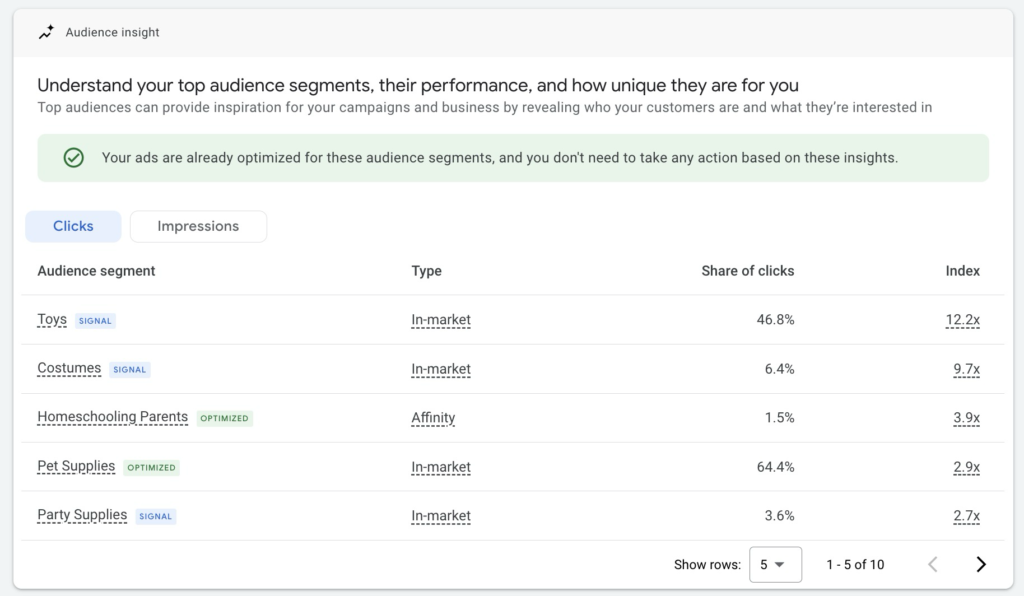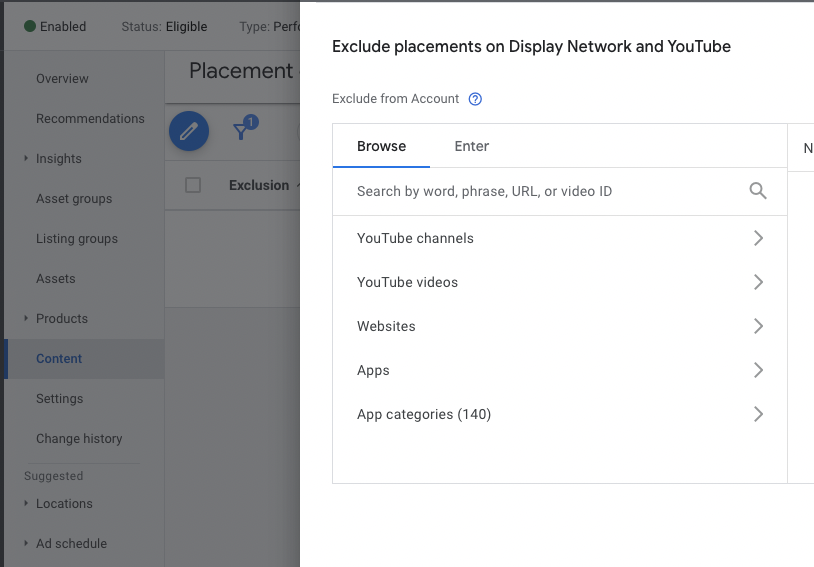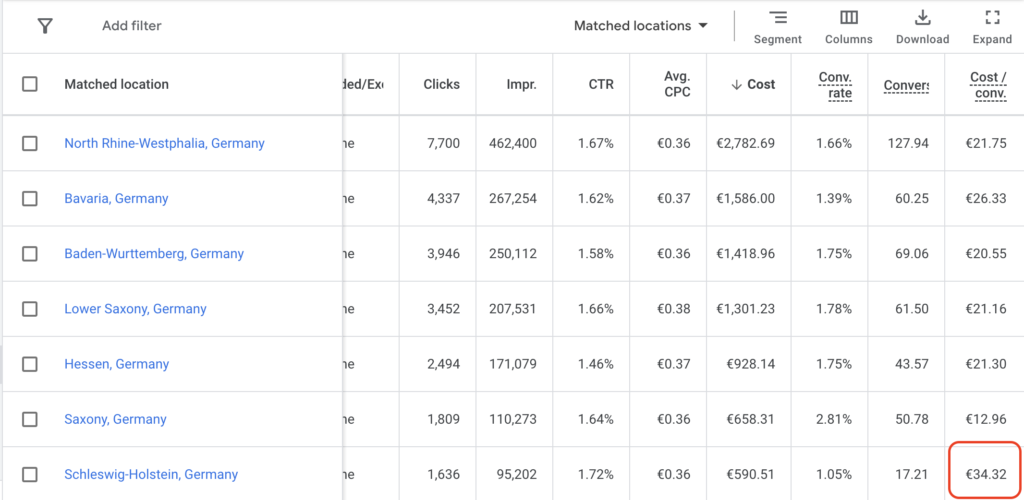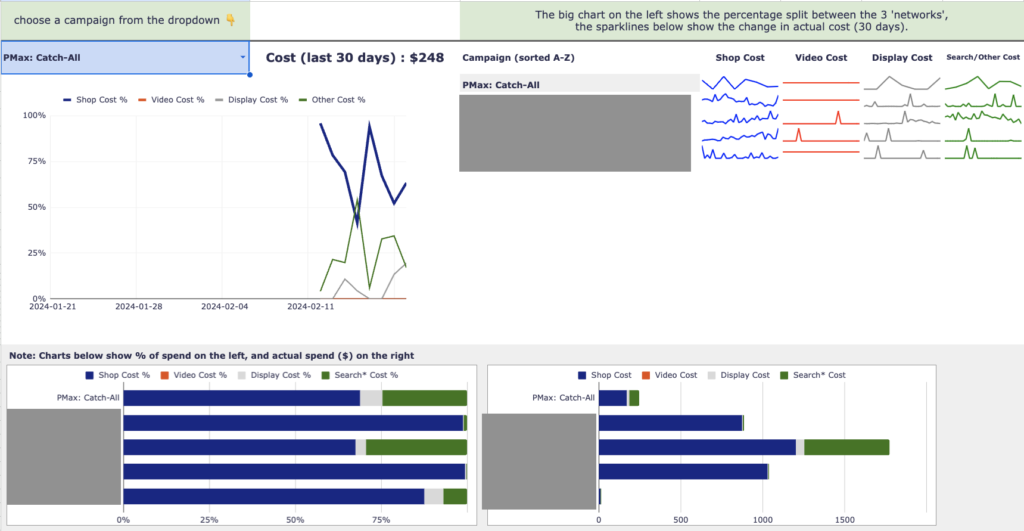von Thimo Hofner

Google’s Performance Max (PMax) campaigns offer the unique opportunity to automate and optimize ads across the entire Google network. However, the effectiveness of this campaign type depends heavily on proper understanding and constant optimization.
In this article, you’ll learn 16 valuable and detailed tips on how to get the most out of your PMax campaigns. From improving your assets to adjusting your bidding strategy – you’ll find everything you need to know here.
Here is an overview of the 16 optimization tips
For each of these tips, you will find detailed instructions on how to proceed and all the starting points you have to optimize your campaigns.
Ready? Let’s go!
Performance Max campaigns can be very helpful in both e-commerce and lead gen. The product feed needed for Shopping ads for e-commerce campaigns offers some more options for optimization.
I am therefore dividing up my optimization tips. In the first part, you will find optimizations that are relevant for all PMax campaigns. This is followed by tips for campaigns with a product feed.
The quality of your ads has a major effect on the overall campaign performance. This is because they form the actual point of contact with potential customers.
With PMax campaigns, you cannot control the exact design of the ads, but the Google algorithm tries to create the best possible ads from the assets that you provide.
Your task is to constantly improve the quality of the texts, images and videos provided. Google gives you information about which assets are clicked well and which are not.
You can find out more about this in this article: Analyzing PMax Assets.

Here is a brief summary and instructions on how to do this:
By taking this systematic approach, you can ensure that your Performance Max campaigns are constantly optimized and achieve the best results.
When creating a PMax campaign, you give the Google algorithm clues about the ideal target group for the respective asset groups with the audience signals. Google uses these as a starting point but also goes beyond this in its search for maximum performance.
Make sure that you define as many relevant audiences as possible. Above all, add your remarketing lists, if available.
If your campaign has already collected enough data, you will find the audiences that have generated a disproportionately high number of impressions, clicks or conversions in the campaign insights.
– in a nutshell:
The target groups that respond above average to your ads.
Here is an example:

In this evaluation, you should look out for audience segments that are performing well but have not yet been added to the campaign as a signal. You can tell whether this is the case by the marking next to the target group:
With the latter, you will often find audiences that are not directly related to your offer or that you have not thought of – and that is precisely the strength of PMax.
If you find new audiences in your evaluation that work particularly well, you should add them to the campaign as an audience signal. This increases the chance that the algorithm will focus even more on high-performing target groups.
In the example above, for example, I would add the “Homeschooling Parents” audience to the audience signals.
Important: If possible, you should focus on audiences that generate conversions. To do this, you should make sure that your conversion tracking is working properly. This is essential for success with PMax campaigns.
Proceed similarly to the audience signals when improving the search themes. They serve as a suggestion for which search queries the PMax campaign should trigger ads.
In reality, however, the algorithm bits on a variety of more or less relevant search queries – regardless of whether you have entered them yourself or not.
You can also find an analysis of this in the campaign insights.
It is worth looking at this report regularly. Keep an eye out for relevant search terms that generate conversions and add them as search themes if you haven’t already done so.
In most cases, it makes sense to exclude search queries for your brand from the PMax campaign.
This is because they can distort the results and lead to the algorithm bidding primarily on brand-related search queries, as these often promise the highest chances of success. This way, you reach interested prospects who would probably have bought from you anyway.
It is not wrong to bid on these search queries, but I would recommend that you clearly separate search queries with and without a brand reference into different campaigns. This will make it easier for you to control how much budget is spent on your brand terms.
You can exclude search queries that contain your brand via the campaign settings. All you have to do is scroll down to Brand exclusions.

There you can then add your brand or company to the list.
If your brand is not yet in Google’s list, you can add it yourself.
Unfortunately, it is not directly possible to add negative keywords to a PMax campaign without the assistance of a Google employee. To effectively integrate negative keywords into your PMax campaigns without having direct access to this feature, follow these steps for a clear and easy-to-implement strategy:
By taking this strategic approach, you can manage your PMax campaign more precisely and avoid wasting your budget on unwanted search queries.

In your Performance Max campaigns, you can exclude unwanted placements to ensure that your ads only appear where they will bring the most value. Here are two ways you can do this effectively:
Use account settings: One option is to globally exclude unwanted placements at the account level. This ensures that your ads do not appear on certain websites or in apps that are not suitable for your brand or product.
Exclusion in the campaign: Another option is direct exclusion in the respective campaign. This gives you the flexibility to control specific placements for each campaign individually.

Unfortunately, Google does not currently provide detailed reports on the placements in Performance Max campaigns. It is therefore advisable to rely on your experience from other campaign types:
Exclude placements that have not performed well in other campaigns to use your resources more efficiently.
In many cases, it can be particularly useful to exclude app placements:
You can do this by excluding all app categories in the settings. This will prevent your ads from appearing in apps that may not fit your target market or target group.
Through these targeted exclusions, you can increase the efficiency of your Performance Max campaigns and ensure that your budget is spent on the most effective placements.
Using ad extensions, also known as assets, in Google Ads is an effective way to make your ads more eye-catching and informative. There are a total of 14 different extensions available to you. The most important ones are:
Sitelinks: Sitelinks allow you to take users directly to other relevant pages on your website, such as an “about us” page or specific product categories. This extension has a strong visual effect and, according to Google, can increase the click-through rate by an average of 20%. The recommended minimum number of sitelinks is four.
Callouts: These small information units, each 25 characters long, offer you the opportunity to emphasize sales features or important unique selling points (USPs). It is recommended to use at least eight callouts.
Structured snippets: These allow you to highlight specific products, services or features in a list presentation. For a bag retailer, for example, different types of bags such as clutches, handbags or rucksacks could be listed.
Price assets: These extensions allow you to display the prices of your products or services directly in the ad, which increases transparency and informs potential customers more quickly.
Promotion assets: They offer an excellent opportunity to highlight special offers or discounts directly in the ad and can significantly increase user attention and interest.
By skillfully using these different assets, you can significantly increase the effectiveness of your ads and thus improve interactions with potential customers.
One of the few aspects you still have full control over with PMax campaigns is the target region. It is therefore worth taking a look at the location reports for optimization purposes.

Concentrate on areas that show poor performance over a longer period of time and with significant traffic – at least 10,000 impressions.
This measure allows you to optimize your resources and focus on regions that actually deliver promising results.
Conversion tracking is essential for the success of your PMax campaigns. This is your tool to show the AI what exactly you want to achieve.
An effective Performance Max campaign requires you to give the AI clearly defined conversions. Precision is key here.
Define the right goals: It is not enough to simply aim to maximize conversions if the real goal is to increase profits. Similarly, it is not effective to just generate a high number of leads if you need conversions that actually lead to paying customers.
Adjust conversion goals: Correctly defining your conversions can make a significant difference to the performance of your campaigns. Therefore, regularly review your conversion goals and adjust them to ensure they reflect your actual business objectives.
Incorporate margin and sales data: Updating conversions to include margin information or data from your sales team can be highly effective. This should be viewed as an ongoing optimization strategy and not just a one-time setup task.
Set up Enhanced Conversions: Google’s Enhanced Conversions enable a more precise collection of conversion data. This technology uses additional user data such as e-mail addresses or telephone numbers in encrypted form to allocate conversions more precisely.
This targeted optimization of your conversion data ensures that your campaigns not only achieve high-quality results in terms of quantity but above all in terms of quality.
When optimizing PMax, it is also worth examining the performance of individual assets groups. This option is somewhat hidden, but by switching to the table view in the asset group overview, you can gain a clear insight.
Here you can see all assets and their performance metrics clearly and add additional columns for specific data as required.

Be careful when pausing asset groups. There is a possibility that certain product groups may fall out of the promotion as a result. A careful decision is required to ensure that this does not have a negative impact on the overall performance of the campaign.
In PMax campaigns, the URL extension is enabled by default. This means that Google could potentially use other pages of your domain as landing pages for your ads.

You do not necessarily have to activate this function. Especially in the lead gen area, it can make sense to only include the pages with high conversion rates.
Analyze landing page performance via Google Analytics: As PMax does not offer direct analysis of landing page performance, it is important to use Google Analytics to gain insights into the effectiveness of your landing pages.
Exclude weak landing pages: If there are pages that are receiving traffic from your PMax campaigns but are not performing well, you should exclude them.
Also make sure that ads are not served to undesirable page areas, such as the login or imprint page.
By considering these points, you can ensure that your PMax campaigns are efficiently targeting the best-performing and most relevant parts of your website.
A big lever in optimizing PMax campaigns is the constant adjustment of the bidding strategy.
In PMax campaigns, you can choose between “Maximize Conversions” (with target CPA if applicable) or “Maximize Conversion Value” (with target ROAS if applicable).
Start without a defined target CPA or target ROAS: It is recommended to start without a specific target for the CPA (cost-per-acquisition) or ROAS (return on ad spend). This allows the campaign to initially learn without being influenced by these targets.
You can find more information on the learning phase of PMax campaigns here.
Introduction of a target after stabilization: As soon as the campaign shows a stable performance over a longer period of time (e.g. 6 weeks), with fluctuations of a maximum of ±20%, you can introduce a target. Set this target to around 20% above the current performance.
Example: The campaign has been consistently generating leads for more than 6 weeks (at least 30 per month) with an average CPA of €50. The CPA fluctuates weekly between $40 and $60.
In this case, you set a target CPA of $60.
Adjustments with active target CPA or target ROAS: If you have already set a specific target for the cost per acquisition (CPA) or the return on ad spend (ROAS), proceed with caution.
Only ever change your target by a maximum of 20%.
It is important to check two things regularly:
– Budget utilization: make sure your advertising budget is being used as intended.
– Stable performance: Your campaign should perform consistently over a period of at least four weeks. This performance should be at least 20% better than the previous target.
Only when these conditions are met should you consider adjusting your target by a further 20%.
Example: Your campaign consistently achieves a ROAS of 280% with an active target ROAS of 200%. You set the target ROAS to 240%. After another 4 weeks, you can raise it further if necessary.
By following these guidelines, you can ensure that your bidding strategy in PMax campaigns is optimally aligned and makes efficient use of your advertising budget.
In the e-commerce sector, there are further starting points for optimizing PMax campaigns via the product feed. If a product feed is available, PMax can also display shopping ads.
In fact, the new campaign type is also Google’s preferred way to advertise products. There is of course still the normal standard Shopping campaign.
If you want to better understand the differences between the two campaign types, you should check out this post: PMax vs Shopping Campaigns.
Some of the following optimization points apply to both campaign types.
Listing groups in Performance Max campaigns are used to divide your products or services into specific categories.
You can view the performance of the individual listing groups in Google in the corresponding report. If there are groups that stand out negatively, you can exclude them:
Exclusion criteria: If a listing group is performing well below average after at least 5,000 impressions, it is advisable to exclude it. This allows you to allocate your budget more efficiently to the groups that deliver better results.
Tip: If you want to advertise all products, it could be helpful to create a catch-all campaign. This is a separate PMax campaign that aims to promote products that are not included in other campaigns.
The product feed is extremely important for the success of your Shopping ads. This is because the ads are automatically created by Google based on the existing product data.
Optimizing the product feed is therefore essential. A comprehensive, up-to-date and relevant feed is essential.
You should pay particular attention to the following identifiers to tell Google exactly what you are selling:
These identifiers are not only crucial for the smooth functioning of your campaigns, but also contribute significantly to optimization and thus to better results.
Using a data feed management solution can be crucial to fully exploit the potential of your e-commerce advertising. Such tools facilitate and automate feed management.
Especially in complex e-commerce sectors, these tools can offer a significant advantage.
An effective campaign structure is crucial for e-commerce success. Here are some key elements for optimization:
Firstly, it is important to review the allocation of products to existing campaigns.
There is a risk that Google will focus on products that sell well, neglecting other products that may be more important to the long-term success of the business.
To do this, regularly check the product reports.
In most cases, it makes sense to divide the products into campaigns by category. This makes it easier to manage the budget for each category.
One possible strategy is to divide products according to certain criteria such as price, performance or margin.
This segmented approach allows you to set a customized target ROAS for each product group. For example, you could promote higher-priced products or those with a higher margin more aggressively to better achieve your business objectives.
Add a catch-all campaign to include products that are not included in other campaigns. This campaign ensures a broad market presence but should be carefully monitored to maintain balance with specialized campaigns.
By taking these steps, you can ensure that your campaigns work efficiently and contribute maximally to your company’s success.
In addition to traditional campaign optimization, there are other tips that can help you better understand your PMax campaign and improve performance.
Performance Max (PMax) campaigns can seem like a black box, as it’s often unclear which Google network is generating the most impressions. Fortunately, there are tools that can help create more transparency: Google Ads scripts.
Scripts in Google Ads are small JavaScript programs that enable the automation of routine tasks and can perform in-depth analyses in your Google Ads account. They can be programmed to extract specific data, create reports or even make automated adjustments to your campaign.

A useful tool for PMax campaigns is Mike Rhodes’ script, which can be found on GitHub. This script generates an automatically updated report in Google Sheets that provides valuable insights into your PMax campaign:
By using this script, you will gain valuable insights into your PMax campaigns that can help you make better-informed decisions and adjust your advertising strategy accordingly.
By the way: You can find even more helpful PMax scripts in this post.
Optimizing your landing pages is a key factor in the success of your PMax campaigns. Google scans your website and uses the data collected to feed the algorithm.
The more precise and relevant the information on your pages is, the better the algorithm can understand which target group your offer is best suited to.
The content of your website not only influences how the algorithm understands your offer but also the automatically generated ad copy. By default, PMax uses the content available on your website to generate text assets.
Therefore, make sure that the texts on your landing pages are clear, precise and tailored to your offer to enable effective ads.
In addition to content, the technical performance of your website also plays a decisive role. A fast page speed ensures that visitors are not put off by long loading times.
The conversion strength of your website is also important. Intuitive navigation, clear call-to-actions and an optimized user experience make it easier for visitors to find their way to a purchase.
By optimizing your landing pages in these areas, you can not only improve the performance of your PMax campaigns but also optimize the overall user experience on your website, which in turn leads to a higher conversion rate and better ROAS.
I hope this post has shown you that there are a few things you can do to optimize your Performance Max campaigns.
It’s less about very small details and more about providing the Google algorithm with the best possible data.
As with any AI: “Garbage in – garbage out”.
But of course, the exact opposite also applies:
“Quality in – Quality out”
If you improve the quality of the input, the results will amaze you.
It is very important in all of this that you give the AI time after making changes and don’t jump to conclusions. You should always see PMax campaigns as long-term assets that slowly and steadily improve.
Thank you for reading this article so far. I hope I have been able to help you. Now have fun optimizing and reaching the maximum performance 😉
Work smart – Clicks in Mind

Hi, my name is Thimo Hofner. I have been working in online marketing as a Google Ads Manager for more than 5 years. Through many courses, trainings and most importantly working with many different clients, I have learned the best strategies for success with Google Ads. On my blog and YouTube, I share my knowledge to help you drive more success with online marketing.